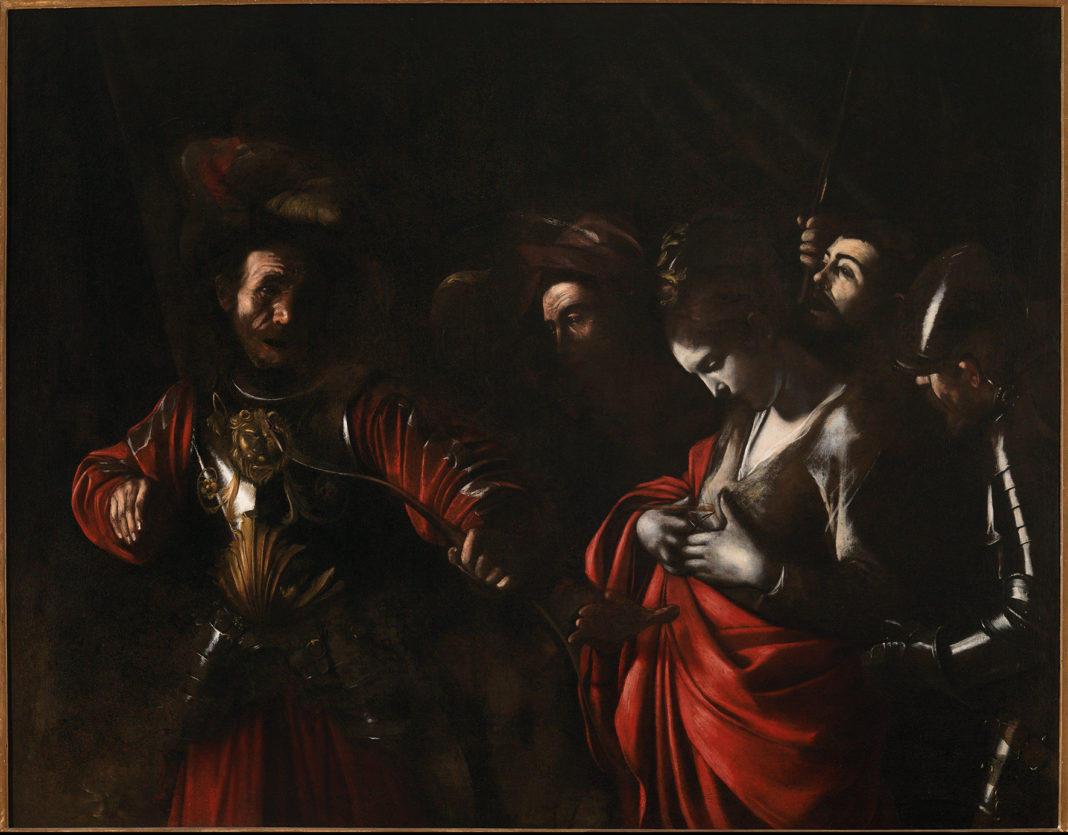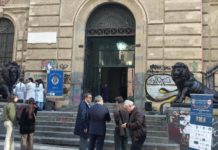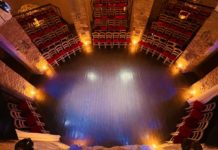Quasi trecentomila persone, oltre tremila al giorno, hanno visitato alla National Gallery a Londra la mostra ‘The last Caravaggio’ incentrata sul Martirio di sant’Orsola, l’opera principale della collezione di Intesa Sanpaolo, solitamente esposta alle Gallerie d’Italia della Banca a Napoli.
L’esposizione, la terza più visitata degli ultimi dieci anni per il museo britannico, si è conclusa domenica 21 luglio ed è stata alla base della collaborazione tra Intesa Sanpaolo e la National Gallery, una delle più note istituzioni museali al mondo, nell’ambito delle celebrazioni londinesi per i suoi duecento anni.
L’opera, l’ultima dipinta dal pittore lombardo nel 1610 durante il suo secondo soggiorno partenopeo, poche settimane prima di morire, è tornata a essere esposta nel museo di Intesa Sanpaolo a Napoli, rientrando a pieno titolo tra le principali attrazioni della città partenopea.
Il Martirio di sant’Orsola è un dipinto a olio su tela (143 × 180 cm) eseguito nel 1610 da Caravaggio e conservato presso le Galleria d’Italia-Napoli, sede museale di Intesa Sanpaolo.
L’opera è di fatto l’ultima pittura del Merisi essendo stata realizzata poco più di un mese prima della sua morte. Commissionato dal principe Marcantonio Doria (la cui famiglia aveva per protettrice proprio Sant’Orsola), il dipinto fu eseguito dal Caravaggio con molta rapidità, probabilmente perché questi era in procinto di partire per Porto Ercole, ove avrebbe dovuto compiere le formalità per essere graziato dal bando capitale. È ben noto che durante quel viaggio il pittore trovò la morte. La fretta fu tale che la tela uscì dallo studio del pittore ancora fresca di vernice e, non essendo perfettamente asciutta alla consegna, degli incauti servi la esposero al sole, circostanza che fu all’origine della sua sofferta conservazione.
L’opera fece ritorno a Napoli nella prima metà dell’Ottocento, pervenendo per via ereditaria al ramo Doria dei principi d’Angri e successivamente, circa un secolo dopo, ai baroni Romani Avezzano d’Eboli, per essere infine acquistata, come opera di Mattia Preti, dalla Banca Commerciale Italiana nel 1972.
La collaborazione tra il museo britannico e la Banca prosegue con il sostegno di Intesa Sanpaolo alla mostra ‘Siena. The Rise of Painting. 1300 – 1350’ che aprirà alla National Gallery dall’8 marzo al 22 giugno 2025 dopo un debutto autunnale al Metropolitan Museum of Art di New York. Con oltre cento dipinti, sculture, oreficerie, tessuti, la mostra approfondirà un momento straordinario agli albori del Rinascimento italiano e il ruolo cardine svolto da artisti senesi come Duccio, Pietro e Ambrogio Lorenzetti e Simone Martini nella definizione della pittura occidentale.
Spiega Michele Coppola, executive director arte, cultura e beni storici Intesa Sanpaolo: «La partecipazione eccezionale del pubblico all’esposizione dell’opera di Caravaggio alla National Gallery a Londra ci rende orgogliosi di aver contribuito, con l’opera più preziosa dalle collezioni di Intesa Sanpaolo, alle celebrazioni di uno dei musei più prestigiosi al mondo. Continueremo a collaborare con la National Gallery attraverso il sostegno alla mostra dedicata a Siena e alla pittura del Trecento nell’ambito delle nostre attività di promozione dell’arte e della cultura italiana all’estero».
Per saperne di più
https://gallerieditalia.com/it/napoli/
Intesa Museum/ Boom of visitors to London for Caravaggio’s Martyrdom of St. Ursula. Which returns to Naples
Nearly three hundred thousand people, more than three thousand a day, visited the exhibition “The Last Caravaggio” at the National Gallery in London, which focused on The Martyrdom of Saint Ursula, the most important work in Intesa Sanpaolo’s collection, usually exhibited at the Bank’s Gallerie d’Italia in Naples.
The exhibition, the third most visited in the last ten years for the British Museum, ended on Sunday 21rst July and was the result of a collaboration between Intesa Sanpaolo and the National Gallery, one of the world’s most famous museum institutions, as part of the celebrations for the 200th anniversary of the National Gallery in London.
The work, the last painted by the Lombard artist in 1610 during his second stay in Naples, a few weeks before his death, has returned to the Intesa Sanpaolo Museum in Naples, making it one of the main attractions of the Neapolitan city.
The Martyrdom of St. Ursula is an oil on canvas (143 × 180 cm) painted by Caravaggio in 1610 and kept at the Galleria d’Italia-Naples, the Intesa Sanpaolo museum headquarters.
In fact, this was Merisi’s last painting, completed just over a month before his death. Commissioned by Prince Marcantonio Doria (whose family had Saint Ursula as its patron saint), Caravaggio executed the painting in great haste, probably because he was about to leave for Porto Ercole, where he was to complete the formalities to be pardoned from the ban on entering the capital. It is well known that the painter died during this trip. Such was the haste that the canvas left the painter’s studio still freshly varnished and, as it was not completely dry when it was delivered, some careless servants exposed it to the sun, a circumstance that was the cause of its suffered preservation.
In the first half of the nineteenth century, the work returned to Naples, where it was inherited by the Doria branch of the Princes of Angri and then, about a century later, by the Romani barons of Avezzano d’Eboli, before being purchased by the Banca Commerciale Italiana in 1972 as a work by Mattia Preti.
The collaboration between the British Museum and the Bank continues with Intesa Sanpaolo’s support for the exhibition ‘Siena. The Rise of Painting. 1300 – 1350’, which will be on display at the National Gallery from March 8 to June 22, 2025, following its debut at the Metropolitan Museum of Art in New York in the fall. Featuring more than one hundred paintings, sculptures, goldsmithing, and textiles, the exhibition will explore an extraordinary moment at the dawn of the Italian Renaissance and the pivotal role that Sienese artists such as Duccio, Pietro, and Ambrogio Lorenzetti, and Simone Martini played in defining Western painting.
Michele Coppola, Executive Director for Art, Culture and Heritage at Intesa Sanpaolo, commented: “The exceptional public participation in the exhibition of Caravaggio’s work at the National Gallery in London makes us proud to have contributed to the celebrations of one of the world’s most prestigious museums with the most valuable works from Intesa Sanpaolo’s collections. We will continue to work with the National Gallery, supporting the exhibition dedicated to Siena and 14th century painting, as part of our activities to promote Italian art and culture abroad”.










